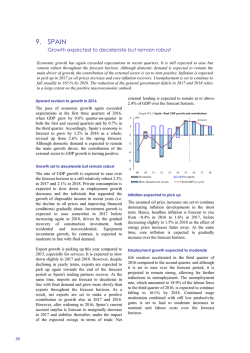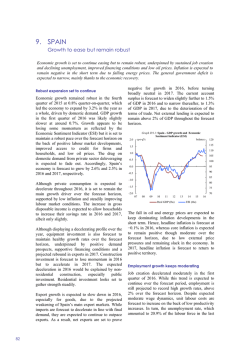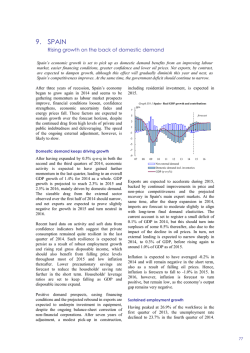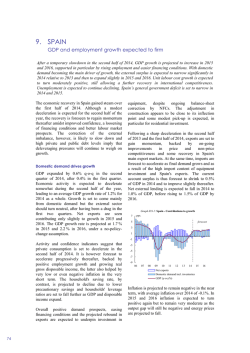
European Commission: Recommendation for a Council
EUROPEAN
COMMISSION
Brussels, 27.7.2016
COM(2016) 518 final
Recommendation for a
COUNCIL DECISION
giving notice to Spain to take measures for the deficit reduction judged necessary in
order to remedy the situation of excessive deficit
{SWD(2016) 263 final}
EN
EN
Recommendation for a
COUNCIL DECISION
giving notice to Spain to take measures for the deficit reduction judged necessary in
order to remedy the situation of excessive deficit
THE COUNCIL OF THE EUROPEAN UNION,
Having regard to the Treaty on the Functioning of the European Union, and in particular
Article 126(9) thereof,
Having regard to the recommendation from the European Commission,
Whereas:
(1)
According to Article 126 of the Treaty on the Functioning of the European Union
(TFEU), Member States shall avoid excessive government deficits.
(2)
The Stability and Growth Pact is based on the objective of sound government finances
as a means of strengthening the conditions for price stability and for strong sustainable
growth conducive to employment creation. The Stability and Growth Pact includes
Council Regulation (EC) No 1467/97 of 7 July 1997 on speeding up and clarifying the
implementation of the excessive deficit procedure1, which was adopted in order to
further the prompt correction of excessive general government deficits.
(3)
On 27 April 2009, the Council decided, in accordance with Article 104(6) of the
Treaty establishing the European Community (TEC) that an excessive deficit existed
in Spain and issued a recommendation to correct the excessive deficit by 2012 at the
latest, in accordance with Article 104(7) of that Treaty. Since then, the Council has
issued three new recommendations to Spain (on 2 December 2009, 10 July 2012 and
21 June 2013) on the basis of Article 126(7) TFEU, which extended the deadline for
correcting the excessive deficit to 2013, 2014 and 2016 respectively. In all three
recommendations, the Council considered that Spain had taken effective action, but
unexpected adverse economic events with major unfavourable consequences for
government finances had occurred2.
(4)
According to the provisions of Article 126(8) of the Treaty, the Council decided on 12
July 2016 that Spain did not take effective action in response to the Council
Recommendation of 21 June 2013.
(5)
According to Article 10(2) of Regulation (EC) No 1467/97, if action by a participating
Member State is not being implemented or, in the Council's view, is proving to be
inadequate, the Council shall immediately take a decision under Article 126(9) of the
Treaty.
1
OJ L 209, 2.8.1997, p. 6.
All documents related to the excessive deficit procedure of Spain can be found at:
http://ec.europa.eu/economy_finance/economic_governance/sgp/deficit/countries/spain_en.htm .
2
EN
2
EN
EN
(6)
The Commission has updated its 2016 spring forecast with information available until
19 July 2016. On this basis, the real GDP growth forecast for 2016 has been revised
upwards by 0.3 percentage points in comparison to the spring forecast, to 2.9%, and
downwards for 2017 (2.3% vs. 2.5% in spring). For 2018, real GDP is forecast to grow
by 2.1%. This compares to growth of 3.2% in 2015. Economic growth is therefore set
to ease but to remain robust, still benefitting from reforms undertaken in response to
the crisis and the successful completion of the financial assistance programme. The
recovery continues to be accompanied by strong job creation, in a context of continued
wage moderation and benefitting from the labour market reforms. Low oil prices also
support growth. At the same time, inflation is expected to be −0.3% in 2016. There
are, however, downside risks to the growth forecast, especially as from 2017, related
among others, to the outcome of the referendum in the United Kingdom on the
membership of the European Union, which has increased uncertainty, with potential
negative implications for trade and domestic demand.
(7)
According to the updated Commission 2016 spring forecast, the general government
deficit is expected to narrow to 4.6% of GDP in 2016, 3.3% of GDP in 2017 and 2.7%
of GDP in 2018 (compared to Stability Programme targets of 3.6%, 2.9% and 2.2% of
GDP in 2016, 2017 and 2018, respectively and a projected deficit outcome of 3.9% of
GDP in 2016 and 3.1% of GDP in 2017 in the spring forecast). The higher deficit
forecast is due partly to the fact that the updated Commission forecast takes on board a
lower amount of measures to contain expenditure at central and regional government
level in response to the March 2016 Commission Recommendation (0.2% of GDP)
than the Stability Programme forecast (0.4% of GDP) on account that some of these
measures have not yet been sufficiently specified to be included in the Commission
forecast on the basis of the usual no-policy-change assumption. However, most of the
difference stems from changes made to the corporate income tax legal framework,
leading to lower advanced payments by companies ('pagos fraccionados') in 2016.
The shortfalls in advanced payments were not quantified in the Stability Programme
and only became apparent in April, at the time of the first instalment, after the cut-off
date of the spring forecast. The updated Commission 2016 spring forecast estimates
these shortfalls at 0.5% of GDP in 2016. As the abovementioned changes create a
permanent delay in the payment of taxes, but not to a change in the tax rate or tax
base, they would not affect revenue from corporate income taxes in a new steady state
(starting in 2017). They result in a temporary loss of tax collection in 2016, which has
been treated as a one-off in the updated spring forecast. For 2017, the differences
between the updated spring forecast and the Stability Programme stem from the
worse-than-expected starting position and the fact that the savings measures taken in
response to the March 2016 Commission Recommendation are not yet sufficiently
specified to be taken into account on the basis of the usual no-policy-change
assumption. The structural deficit is expected to increase by 0.4% and 0.1% of GDP in
2016 and 2017, respectively, and to remain unchanged in 2018. However, in 2016, the
projected increase of the structural deficit is partly driven by the fact that the current
outlook for inflation and nominal GDP growth is lower than the one underpinning the
2016 budget, which adversely affected structural government revenue while not
allowing to adjust expenditure.
(8)
The general government gross debt-to-GDP ratio rose from 36% in 2007 to about 99%
in 2014. In 2015, the debt ratio was more or less stable, as net sales of financial assets
offset the negative impact of the deficit growing faster than nominal GDP growth.
According to the updated Commission 2016 spring forecast, the debt ratio is expected
to peak at 100.6% of GDP in 2017, whereas the spring forecast projected the debt to
3
EN
peak at 100.3% of GDP in 2016. Although Spain does not appear to face immediate
risks of fiscal stress arising from this high debt ratio, debt-sustainability risks will
significantly increase in the medium term if the budgetary position is not improved. In
the longer term, risks to fiscal sustainability are set to be reduced thanks to the positive
impact of reductions in age-related expenditure3.
EN
(9)
According to Article 5 of Regulation (EC) No 1467/97, in the Council decision to give
notice to take measures for the deficit reduction in accordance with Article 126(9) of
the Treaty, the Council shall request that the Member State achieve annual budgetary
targets which, on the basis of the forecast underpinning the notice, are consistent with
a minimum annual improvement of at least 0.5% of GDP as a benchmark, in its
cyclically adjusted balance net of one-off and temporary measures. However, the fact
that this Council decision to give notice is adopted in the second half of the year
amplifies the fiscal effort needed to achieve a given annual improvement of the
structural balance. It is also important to bear in mind that the baseline scenario for the
new adjustment path starts with a deterioration of 0.4% of GDP of the structural
deficit, which is at least in part the result of the inflation turning out lower than
projected in the scenario underpinning the 2016 budget – an event that is largely
outside the control of the government. Taking this into account, it appears appropriate
not to request further structural measures in 2016.
(10)
Considering that no further structural measures should be requested in 2016, granting
Spain one additional year for the correction of its excessive deficit, which is the rule
according to Council Regulation (EC) No 1467/97, would require an annual
improvement of the structural balance in 2017 which would have a too negative
impact on growth. Therefore, it seems adequate to extend the deadline for Spain to
bring an end to its excessive deficit situation by two years.
(11)
Therefore, a credible and sustainable adjustment path would require Spain to reach a
general government deficit of 4.6%, 3.1% and 2.2% of GDP in 2016, 2017 and 2018,
respectively, which is consistent with a deterioration of the structural balance of 0.4%
of GDP in 2016 and a 0.5% of GDP improvement in both 2017 and 2018. These
budgetary targets also take into account the need to compensate for second-round
effects of fiscal consolidation on public finances, through its impact on the wider
economy.
(12)
In order to reach those targets, further structural measures with an estimated impact of
0.5% of GDP in both 2017 and 2018, are considered necessary. Savings for 2017 and
2018 could among others include the reduction of the number and scope of tax
expenditures, in particular the reduced VAT rates, in order to achieve the required
structural effort.
(13)
In addition, strict enforcement at all government levels of the preventive and
corrective mechanisms provided for in Spain's Stability Law could be conducive to a
timely and durable correction of the excessive deficit. This could be achieved through
greater automaticity in their implementation. Moreover, the contribution of the
Stability Law's spending rule to the sustainability of public finances could be enhanced
by further clarifying the coverage and definition of the spending categories needed for
its computation and by explicitly calling on the non-compliant public administrations
to make up for spending slippages in the year following their occurrence.
3
European Commission (2016), "Fiscal Sustainability Report 2015", European Economy, Institutional
Paper No. 018.
4
EN
(14)
Spain should also pay due attention to the qualitative aspects of public finances,
including its public procurement policy. The number of wrongdoings having an impact
on the application of EU public procurement legislation brought to the Commission’s
attention in recent years has been significant. The data show that there are disparities
in the implementation of public procurement across contracting authorities and entities
and that insufficient ex-ante and ex-post control mechanisms hinder the correct and
uniform application of public procurement legislation. Spain stands out for a low
publication rate of contract notices and a relatively high use of the negotiated
procedure without prior publication compared with other Member States. This
translates into limited competition from undertakings from other EU countries and
frequently, into direct awards, with implications in terms of higher general
government expenditure. The limited use of centralised or joint procurement
instruments prevents efficiency gains which would contribute to fiscal savings. The
absence of an independent body in charge of ensuring efficiency and legal compliance
in public procurement throughout the country hampers the proper implementation of
procurement rules and may create opportunities for wrongdoings, both of which have
negative impacts on the situation of Spain's public finances.
(15)
To facilitate the success of the fiscal consolidation strategy, it will also be important to
back the fiscal consolidation by comprehensive structural reforms, in line with the
Council recommendations addressed to Spain in the context of the 2016 European
Semester and in particular those related to the correction of its macroeconomic
imbalances.
(16)
According to Article 126(9) of the Treaty, the Council may, as part of its decision to
give notice under this Article, request the Member State concerned to submit reports
on the adjustment effort in accordance with a specific timetable. According to Article
5(1a) of Regulation (EC) No. 1467/97, the Member State report shall include the
targets for government expenditure and revenue and specify the fiscal policy measures
on both the expenditure and the revenue side, as well as information on the policy
actions being taken in response to the specific Council decisions. In order to facilitate
the monitoring of the deadline for compliance with the recommendations contained in
this notice, as well as the deadline for correction of the excessive deficit, Spain is
requested to submit such a report by 15 October 2016, in parallel with its 2017 Draft
Budgetary Plan.
(17)
Spain should also report to the Commission and the Economic and Financial
Committee as required under Article 10 of Council Regulation (EU) No 473/2013 in
accordance with the specifications laid down in Commission Delegated Regulation
(EU) No 877/2013. The report should be submitted for the first time by 15 January
2017 and on a three-monthly basis thereafter.
HAS ADOPTED THIS DECISION:
Article 1
EN
1.
Spain shall put an end to the present excessive deficit situation by 2018.
2.
Spain shall reduce the general government deficit to 4.6% of GDP in 2016, to 3.1%
of GDP in 2017 and to 2.2% of GDP in 2018. This improvement in the general
government deficit is consistent with a deterioration of the structural balance by
0.4% of GDP in 2016 and a 0.5% of GDP improvement in both 2017 and 2018,
5
EN
based on the updated Commission 2016 spring forecast. Spain shall also use all
windfall gains to accerelate the deficit and debt reduction.
3.
In addition to the savings already included in the updated Commission 2016 spring
forecast, Spain shall adopt and fully implement consolidation measures for the
amount of 0.5% of GDP in both 2017 and 2018.
4.
Spain shall stand ready to adopt further measures should risks to the budgetary plans
materialise. Fiscal consolidation measures shall secure a lasting improvement in the
general government structural balance in a growth-friendly manner.
5.
Spain shall adopt measures to strengthen its fiscal framework, in particular with a
view to increasing the automaticity of mechanisms to prevent and correct deviations
from the deficit, debt and expenditure targets and to strengthening the contribution of
the Stability Law's spending rule to public finance sustainability.
6.
Spain shall set up a consistent framework to ensure transparency and coordination of
public procurement policy across all contracting authorities and entities with a view
to guaranteeing economic efficiency and a high level of competition. Such
framework shall include appropriate ex-ante and ex-post control mechanisms for
public procurement to ensure efficiency and legal compliance.
Article 2
The Council establishes the deadline of 15 October 2016 for Spain to take effective action
and, in accordance with Article 5(1a) of Regulation (EC) No 1467/97, to submit a report to
the Council and the Commission on action taken in response to the Council notice. The report
shall include the targets for government expenditure and revenue and specify the discretionary
measures on both the expenditure and the revenue side, as well as information on the actions
being taken in response to the specific Council recommendations to strengthen its fiscal
framework and its public procurement policy framework in accordance with paragraphs 5 and
6 of Article 1.
Article 3
This Decision is addressed to the Kingdom of Spain.
Done at Brussels,
For the Council
The President
EN
6
EN
© Copyright 2024





